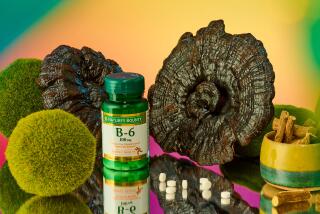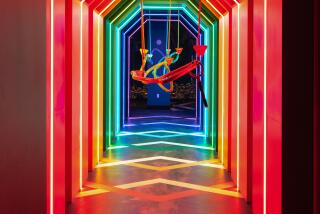‘Fluid-Gel’ Soft Drink Has Market in Suspense
- Share via
NEW YORK — It defies description, but let’s try anyway: a lava lamp you can drink. A neon-pastel tapioca cocktail. A chewable liquid. Or this more visceral, if repulsive, assessment: fruit-flavored phlegm in a bottle.
Throw out traditional ideas of what a soft drink should be. There’s a new beverage on the shelves called Orbitz, and--mucosity aside--it’s downright weird. It uses new “fluid-gel” technology that allows tiny gelatinous dumplings to remain suspended in liquid. Why the jump was made from just having the technology to using it in drinks is unclear and perhaps better left that way.
Consuming Orbitz is rather unsettling. Though the tastes are familiar--fruity market standards like raspberry citrus and blueberry melon strawberry--the pliable orbs hit your tongue with a feeling surely akin to drinking one of those souvenir balls you shake to make faux snow.
Unflattering descriptions? No matter. It’s the kind of publicity that Clearly Canadian, which manufactures Orbitz, loves. The company wants consumers to look at the lumpy liquid and think postmodern cool.
“People want to be entertained in all aspects of their lives,” says spokesman Jonathan Cronin. “We want to give them something that’s not only delicious but entertaining--something that makes the person who brings Orbitz into the room the center of attention for a few moments.”
This, it seems, is the soft-drink industry’s new credo. The appearance of Orbitz comes months after an equally odd, though perhaps understandable, beverage debut: Water Joe, the spring water with a caffeine kick.
“Beverage makers are getting desperate,” says Al Ries, a marketing analyst who monitors the beverage industry. “They’re looking for their next big hit. And in doing so, they feel that they need something really crazy.”
Consider the beverage landscape in recent years. Jolt cornered the market on supercaffeinated cola, and the once-lowly spring-water bottle is now tres cool. Snapple pioneered the flavored iced-tea movement and threw in various odd concoctions such as “Guavamania.” Really, what was left?
“We’re certainly in a period where the consumer marketplace and the consumer are sort of inoculated against certain products,” says Paul Lukas, who analyzes unusual products for New York magazine and his self-published zine, Beer Frame. “It’s a much more educated consumer market than it’s ever been. So it requires shock value.”
But unusual itself is nothing new, be it packaging or content. Miller led the charge of the Lite brigade years ago, and the early 1980s brought drink boxes, strange in their era. Capri-Sun packed its potables in pouches punctured with a straw. And Maxwell House introduced both brewed coffee concentrate in a plastic squirt bottle and ready-to-drink coffee in a carton, like milk. Neither flourished.
Pepsi had its own pitfalls. Pepsi AM appeared in the late ‘80s to compete with Jolt, but analysts say it failed because the name implied breakfast. Crystal Pepsi (1992), aimed at the anti-artificial coloring contingent, also stiffed, as did Miller Clear Beer.
Water Joe, already being sold in 45 states, was concocted by 29-year-old David Marcheschi, who used late-night college study sessions as inspiration. He didn’t like coffee or cola and drank a lot of water, so he remembers thinking the magic words: “This could become a caffeinated alternative.”
“The market is looking for new ideas. It was getting kind of stale with the iced teas,” Marcheschi says. “And we’re finding our niches--athletes, people who don’t want their teeth stained. We get a lot of rock bands that call us. They’re drinking it on stage. You don’t run around stage with a cup of coffee.”
Groundbreaking, perhaps--imagine making coffee or frozen orange juice with it. It might even last.
But none of those innovations, however weird, feature floating lumps. What are Orbitz orbs made of? “Vegetation, if you will,” Cronin says proudly. The technical term: hydrocolloid gellan gum.
The 9-year-old Clearly Canadian, based in Vancouver, British Columbia, acknowledges Orbitz’s attraction to the PlaySkool demographic, but wants to create a retrocool “Jetsons mentality” that targets ages 12 to 17 or even college students (a Cuervo-Orbitz shooter, perhaps?).
Cronin reports better-than-expected sales--a million cases by year’s end. But that doesn’t translate into respect.
“This could be the pet rock of the beverage industry,” says Ed Rogers, director of concept development for the New Products Showcase and Learning Center in Ithaca, N.Y.
Katie Couric tried Orbitz on NBC’s “Today.” Her gut reaction: “Ugh. Why?” She later pronounced it “a little interesting.” And BevNet,” a World Wide Web beverage review site, called it “just the strangest thing we have ever seen.”
Not to be outdone, the Associated Press conducted an unscientific poll at its headquarters, forcing more than a dozen employees to drink Orbitz. Just two gave a tentative thumbs up: “It kind of grows on you.”
To Cronin, that’s high praise. “That’s the perfect reaction: ‘What is this stuff?’ and then, ‘Hey--it’s not as bad as I thought it would be.’ ”
More to Read
Eat your way across L.A.
Get our weekly Tasting Notes newsletter for reviews, news and more.
You may occasionally receive promotional content from the Los Angeles Times.










